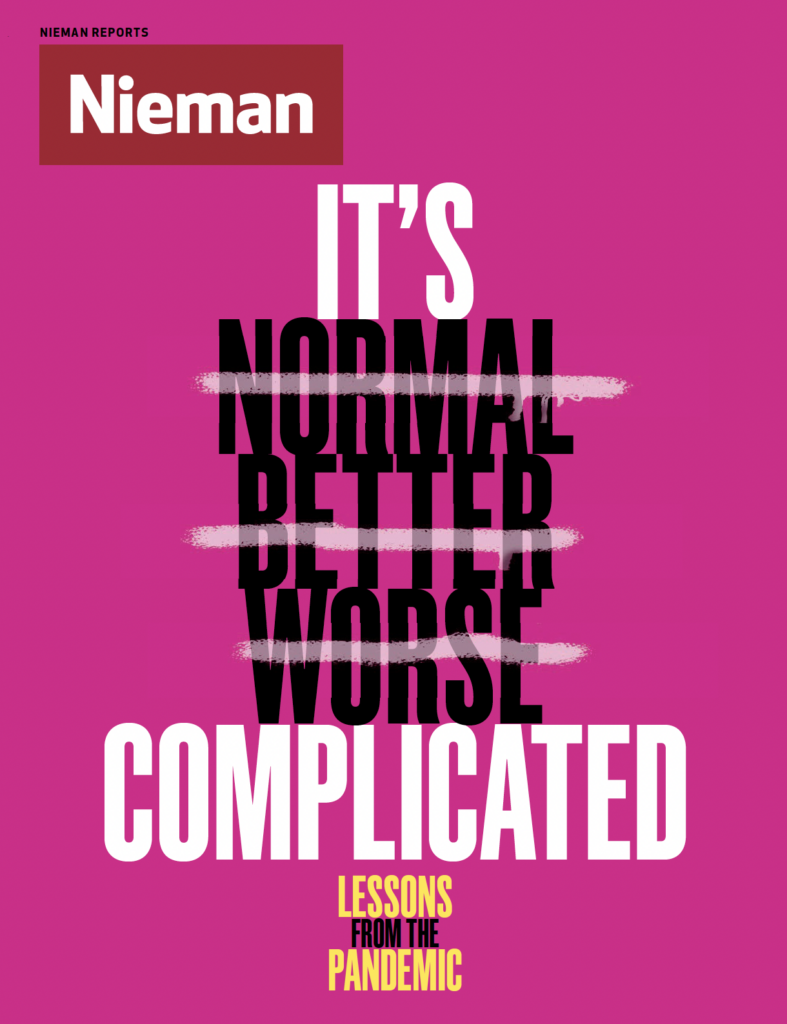
Hope that the coronavirus is finally being brought under control has prompted plans for a return to “normal.” But can, or should, journalism return to a pre-pandemic “normal?” Across newsrooms, the way we once covered education, sports, food, politics — any beat — is unlikely to be sufficient for the new moment we are entering.
What are the lasting lessons of this time? And how should we do journalism differently moving forward? These are the questions Nieman Reports explores in our essay series, Lessons from the Pandemic.
Some reports linked the vaccine developed by Oxford University to a few unusual cases of blood clots, and several European countries were considering suspending its distribution. In my country, Italy, prosecutors were investigating the deaths of some individuals who passed away days or weeks after getting their jabs. But the connection between the vaccine and some severe side effects was not established.
The European Medicines Agency (EMA) did not ban or discourage any government from distributing the AstraZeneca vaccine and, after carefully reviewing the cases, it mentioned a “possible” link with blood clots and confirmed that serious adverse events were “very rare.” “The benefits of the vaccine … continue to outweigh the risk of side effects,” the EMA wrote in a statement.
As of April 4, the EMA had reviewed 222 cases of unusual thrombosis reported in the EU drug safety database, which collects information on the European Economic Area and the UK; at that point, some 34 million people had already received the AstraZeneca vaccine. Statistically, a person is more likely to be struck by lightning or die in an accident at home than to experience fatal side effects from the AstraZeneca vaccine. When La Repubblica ran its much-discussed headline, European health authorities had not released a final assessment of the case and did not caution against getting the vaccine.
A few unconfirmed cases were enough to prompt an unjustified wave of panic over the vaccine. In addition, the Italian Medicines Agency (AIFA) imposed a temporary ban on a supposedly defective batch of the vaccine that may have been linked to some of the deaths prosecutors were investigating. Following the EMA’s review, Italy resumed the use of AstraZeneca jabs, and the national agency “ruled out problems related to quality and production.” But the amalgam of negative reports contributed to skepticism over the vaccine.
The scare was amplified by the media, and La Repubblica’s headline stood out. Its language suggested to readers how they should feel, instead of describing the facts upon which readers should base their feelings.
I don’t want to read too much into a single headline, but I think it captures several things that need to be fixed in journalism in the post-Covid world.
The pandemic raised an unmet demand for trustworthy news outlets that base their reporting on scientific evidence while keeping in check tendencies to over-emotionalize the facts or stoke fear. Initially, navigating the complexities of a highly contagious and mysterious virus was a daunting task. But it also offered news outlets the opportunity to earn readers’ trust by offering solid, evidence-based, and well-sourced reporting.
After over a year of skimming through scientific papers, crunching numbers, processing data, and carefully attempting to separate signal from noise to build a solid bond of trust with audiences, some European media’s rush to panic over the AstraZeneca case was a significant step back. And things got worse. A few days after the first reports about the potentially fatal blood clots appeared, several European nations, including Germany, France, and Italy, temporarily suspended distribution of the AstraZeneca vaccine, calling for the EMA to review the case.
The political decision provided a sense of legitimacy to the unsubstantiated idea that the risks associated with the vaccine outweighed its benefits, reinforcing the alarmist narrative promoted by some news outlets. That introduced a new dimension to the problem of credibility for the media. In order to gain trust, the media would have to challenge the whole political decision-making process, even though the governments justified it by appealing to the “precautionary principle” or pledging total transparency over vaccine side effects.
In the end, the EMA confirmed what it had never denied in the first place: the vaccine was safe, effective, and only associated with very rare serious adverse effects.
But the uproar contributed to the erosion of people’s trust in the AstraZeneca vaccine. An undersecretary in Italy’s Ministry of Health estimated that 15 to 20 percent of the Italian population would end up refusing the AstraZeneca jab. Undoubtedly, some media contributed to amplifying its risks while implicitly downplaying the enormous benefits to the many millions of people who had been safely vaccinated already.
Other outlets attempted to offer a more balanced, data-based approach. “Tension in Europe over AstraZeneca,” the legacy newspaper Il Corriere della Sera wrote in a front–page headline the same day as La Repubblica referred to fear. Il Corriere della Sera’s coverage focused on the different approaches taken by various EU countries.
As time went by, coverage proved to be more nuanced and responsible than the headlines that dominated the early days of the case. Weeks later, La Repubblica ran a series of stories illustrating how, for instance, “Aspirin is more dangerous” than the AstraZeneca vaccine.
The AstraZeneca case is a cautionary tale for journalists chasing the ultimate good — trust.
In the early stages of the pandemic, media all over the world struggled to provide trustworthy, evidence-based information, and even to admit “We don’t know” when that was the case. In a sense, the pandemic was an exercise in humility. It forced reporters and editors to face a plethora of unknowns and to refrain from giving credit to unsubstantiated claims or poorly vetted sources. But in time, as the media grew more confident in covering the crisis, the risk of complacency also grew, and the bond of trust painstakingly built with readers has again been put to the test.
The coverage of the AstraZeneca story captures the idea that trust is not gained once and for all. Trust needs to be earned, and then earned again, every day. It’s a marathon, not a sprint. That’s a lesson media all over the world are learning, sometimes the hard way.
It’s difficult to know how the pandemic will affect newsrooms in the long run, but trustworthiness and credibility should be at the center of our efforts to build a healthier media ecosystem.
Mattia Ferraresi, a 2019 Nieman Fellow, is the managing editor for Italy’s Domani newspaper.
Lessons from the Pandemic
Hope that the coronavirus is finally being brought under control has given rise to planning for a return to “normal.” But can, or should, journalism return to a pre-pandemic “normal?” Across newsrooms, the way we once covered education, labor, theater—any beat—is unlikely to be sufficient for the moment we are entering. What are the lasting lessons of this time, and how should we do journalism differently? These are the questions to which Nieman Reports is seeking answers in our essay series, Lessons from the Pandemic.



